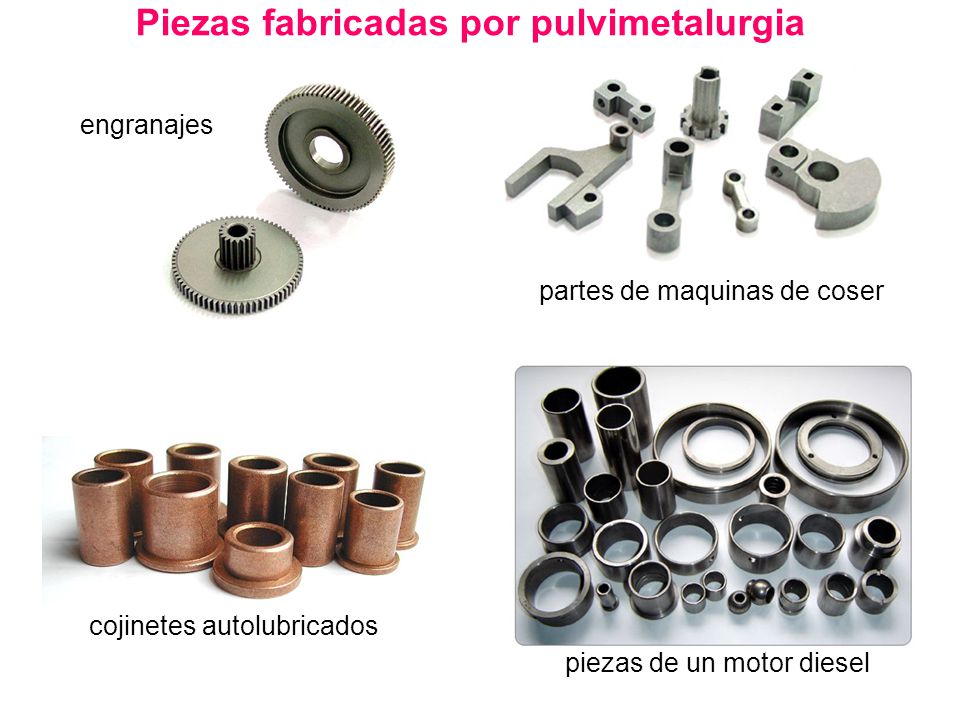Metallurgy of powders. 👷👷
Hello friends in this post I am going to talk about metal powder processing or also known as powder metallurgy.
This process consists in manufacturing metal parts from the different types of metallic dust, for example: Iron, Copper, Stainless Steel, Tungsten Carbon among others.
But the most used for the production of powders is copper and iron where after being compacted they are heated in a controlled atmosphere (sintered) to obtain the piece, but for that a due process is necessary that I will mention them.
There are different ways to produce metallic powders depending on the physical and chemical characteristics of the metals used. Some of these are:
Machining: coarse particles are produced and used mainly to produce magnesium powders. In this grinding process, the material is crushed with rotating roller mills and by stamping, breaking the metals, thus obtaining irregular particles of any fineness.
Perdigonado: this method consists of emptying the molten metal in a sieve and cooling it by letting it fall in water. In this process, spherical or pear-shaped particles are obtained.
Spraying: consists of the spraying of the metal and its cooling in air or water. It is an excellent method for the production of dust from almost all low melting metals such as lead, aluminum, zinc and tin.
Once the powder is obtained, the manufacturing process of the piece begins...
This process is basically composed of 3 stages:
The mixture, The compacted and the sintered.
- The mixture: in this stage a homogenous mixture of the materials must be reached and the lubricants added.

Lubricants help reduce friction between the metal powder and the tool surfaces used in the mixing process and reduce friction during compaction.
- The compacted: in this process the powder that is previously mixed in a steel mold with the shape of the desired piece is introduced, where the powders are pressed from 150 - 900Mpa. (megapascal)
There are different methods of compaction, some of these are:
-Troquel.
-Isostatic.
-Wrought and extruded.
-continuous
I will only mention the function of the Troquel so as not to make the publication longer.
The Troquel is the most used for compaction, first the die is filled, then pressed and expelled using pressures of 20 to 50 ton/pulg2
- Sintering: It is the thermal treatment of compacted powders at a temperature lower than the melting temperature of the base metal of the mixture.
It is the welding of the dust particles between them and diffusion of the alloying elements.
The sintering temperatures in some metals are:
-iron: 1095 °C
-Copper: 870 °C
-Stainless steel: 1180 °C
-Carbon of tungsten: 1480 °C
complementary processes:
Calibrated: it is the re-compaction of the synthesized piece to improve dimensional accuracy and surface condition.
Impregnation in oil: It is the filling of the porosities with a lubricating oil to confer self lubrication. It is very similar to the impregnation operation, except that in this case it uses a molten metal to fill the pores. Some of the most commonly used metals are copper and lead.
Thermal and surface treatments: thermal treatments are processes where only temperature is used as variable variable modifier of the microstructure and constitution of metals and alloys, but without changing its chemical composition. The objective is to improve the mechanical properties of metals and alloys while the surface treatments vary the surface chemical composition of the steels, adding other elements, mainly hardness, or resistance to wear and corrosion resistance.
Once obtained the desired pieces can be used for different applications in the industry, some of these products generated are:
- Porous products: Bearings, metal filters, pressure regulators and / or flow regulators.
- Products of complex shapes: that require considerable mechanization with other processes (small gears, rotors for pumps).
- Hard machining products: (cutting tools).
- Products with high melting point materials: refractory materials.

Some of the advantages of the powder metallurgy process is that the prices are very competitive in relation to other manufacturing methods and almost 100% of the raw material is used and of course it has a high degree of energy saving and its technology is not contaminating .
I hope you liked this post about the processing of metal powders and thanks for taking a few minutes of your time to read me =)
Congratulations @danielbg! You have completed some achievement on Steemit and have been rewarded with new badge(s) :
Click on any badge to view your own Board of Honor on SteemitBoard.
For more information about SteemitBoard, click here
If you no longer want to receive notifications, reply to this comment with the word
STOPDo not miss the last announcement from @steemitboard!